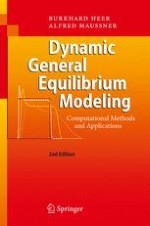2009 | OriginalPaper | Buchkapitel
Computation of Stationary Distributions
Erschienen in: Dynamic General Equilibrium Modeling
Verlag: Springer Berlin Heidelberg
Aktivieren Sie unsere intelligente Suche, um passende Fachinhalte oder Patente zu finden.
Wählen Sie Textabschnitte aus um mit Künstlicher Intelligenz passenden Patente zu finden. powered by
Markieren Sie Textabschnitte, um KI-gestützt weitere passende Inhalte zu finden. powered by
This chapter introduces you to the modeling and computation of heterogeneous-agent economies. In this kind of problem, we have to compute the distribution of the individual state variable(s). While we focus on the computation of the stationary equilibrium in this chapter, you will learn how to compute the dynamics of such an economy in the next chapter.
The representative agent framework has become the standard tool for modern macroeconomics. It is based on the intertemporal calculus of the household that maximizes lifetime utility. Furthermore, the household behaves rationally. As a consequence, it is a natural framework for the welfare analysis of policy actions. However, it has also been subject to the criticism whether the results for the economy with a representative household carry over to one with heterogenous agents. In the real economy, agents are different with regard to many characteristics including their abilities, their education, their age, their marital status, their number of children, their wealth holdings, to name but a few. As a consequence it is difficult to define a representative agent. Simple aggregation may sometimes not be possible or lead to wrong implications. For example, if the savings of the households are a convex function of income and, therefore, the savings rate increases with higher income, the definition of the representative household as the one with the average income or median income may result in a consideration of a savings rate that is too low.
1
In addition, we are unable to study many important policy and welfare questions that analyze the redistribution of income among agents like, for example, through the reform of the social security and pensions system or by the choice of a flat versus a progressive schedule of the income tax.
